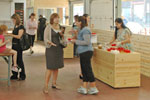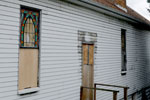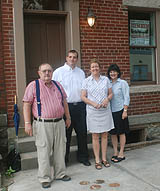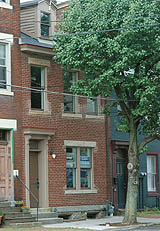
Category Archive: Historic Properties
-
Public Market in Strip to Open Sept. 10, Feature Specialty Items
By Michael Machosky, PITTSBURGH TRIBUNE-REVIEW
Tuesday, August 31, 2010
Siblings (from left), Xanthe Schandelmeier, 5; Coco, 9; and Vivienne, 7, of Squirrel Hill, sample sweets at Prasad Potluri's Spice by Tamarind booth in the Pittsburgh Public Market. More than 40 vendors will showcase their wares in a 10,000-square-foot area of the Produce Terminal Building. The grand opening will be Sept.10. The market will be open Fridays, Saturdays and Sundays. Heidi Murrin | Tribune-Review
From homemade pierogies and duck pate with pistachios and fresh herbs to old-school Italian ice and locally-brewed beer — the Pittsburgh Public Market is so close, you can almost taste it.
“It will be 45 years in November since Pittsburgh had a public market,” said Becky Rodgers, executive director of Neighbors in the Strip, who vividly remembers the last one — the long-demolished North Side Market House. “My great uncle Bob was a butcher there. My whole family used to go — it was like a sight-sound-smell extravaganza.”
Starting with a soft opening Friday, the long-delayed Pittsburgh Public Market finally will open to the public. On Sept. 10, there will be a clamorous Grand Opening marked by the ringing of bells — the public is invited to bring their own to add the racket.
Unlike Pittsburgh’s seasonal farmers markets, this indoor market will be open every weekend year-round. The $1.3-milllion project will have more than 40 vendors in 10,000 square feet of space — which is only a small slice of the blocks-long Produce Terminal Building along Smallman Street, where it is housed. The entrance is near 17th Street.
It’s been a delicate balancing act from the start, which began in 2001. Spaces from 6,500 square feet to 30,000 square feet were considered. And finding a way to avoid diverting business from the Strip’s established food purveyors was a major concern.
“You’ll notice we don’t have a fish place in our market — that’s a very usual kind of thing to have in a market,” said Cindy Cassell, the market manager for Neighbors in the Strip. “We don’t have a cheese place. We’re really working hard not to replicate existing niche markets.”
Vendors quite literally are all over the map — from Gosia’s Pierogies to Sito’s Mediteranean dressings, to Ekh’s authentic Indian vegetarian dishes, to Mushrooms for Life, foraged from around Western Pennsylvania.
Kevin Costa was slicing up duck pate and “Gin & Juice Salami” Tuesday morning at the Crested Duck Charcuterie, a specialty meat market with a booth near the entrance.
“We wanted to start our own business, but it would have been impossible to duplicate the foot traffic of the Strip, so this is perfect,” Costa said.

On Sept. 10, the PIttsburgh Public Market will open for business inside the Produce Terminal Building in the Strip District. More than 40 vendors will showcase their wares with everything from baked goods to artwork, barbecues to microbrews. Heidi Murrin | Tribune-Review
Starting a business is a lot less daunting for vendors when they’re paying $25 a day for a 10-foot-by-6-foot booth or $50 a day for a 10-foot-square booth.
“One of our challenges has been to get the concept across that, while this is not necessarily full-time, it’s also not a farmer’s market where you just show up and put your tablecloth down,” Cassell said. “It’s a little more permanent than that. So there is some planning involved for your booth. The booths are small, but from a financial perspective, I think it’s very accessible for a new business.
“We do have a lot of startups that are coming in,” she said. “That’s one of our goals, to incubate new businesses. And you know everything will be realized when they grow up and need a storefront, and can, hopefully, take an empty storefront in the neighborhood.”
Other vendors just want a little more visibility.
The Spice by Tamarind booth stocks Indian spices, snacks, chutneys, ready-to-eat meals and specialties like eggless cakes. Owner Prasad Potluri runs several Indian restaurants and small grocers in the region.
“It’s to make people aware of the restaurants and food,” Potluri said of the reason behind his participation.
For some, it’s simply a way to make it easier for customers to find their product.
Scott Smith, of East End Brewery, always assumed most of the sales for his Big Hop IPA and Black Strap Stout would be wholesale to bars and restaurants. But craft-beer fans just kept searching out the tiny, out-of-the-way brewery.
“We’re in an unmarked building in Homewood, and half our business is walk-in traffic,” Smith said.
Now, customers can sample Fat Gary Nut Brown Ale and Pedal Pale Ale at the Pittsburgh Public Market, and fill up their growlers to take home.
Not everything in the market is edible.
Babouche sells Moroccan crafts, jewelry, scarves and leather goods. Iron Eden is renowned for beautiful ironwork — flowers, trellises, sculpture — often made from recycled scrap metal. Jenn’s Jems features knit and crocheted items, and handmade jewelry.
Markets in other cities — like Cleveland’s West Side Market and Seattle’s Pike Place Market — have become first-day tourist attractions.
The Pittsburgh Public Market is starting on a much smaller scale, of course, but drawing new shoppers to the Strip is part of the plan.
“When we had Campos do a consumer market survey for us in 2006, at that time, we were planning for about 30,000 square feet,” Cassell said. “According to the consumer survey, it would add about 12,000 additional shoppers to the Strip every week. Now we’re scaled back in 10,000 square feet. But one of our goals is to increase the customer base for the entire Strip.”
Pittsburgh Public MarketWhen: Opens Friday, with Grand Opening Festivities Sept. 10-12
Hours: 9 a.m.-7 p.m. Fridays, 9 a.m.-5 p.m. Saturdays, 10 a.m.-4 p.m. Sundays
Where: 17th and Smallman streets, Strip District
Details: 412-281-4505 or website
-
Challenge Grant Generates $100,000 for Historic Religious Properties Program
PHLF News
Wednesday, August 04, 2010Thanks to $25,000 in challenge grants from two anonymous donors, The Pittsburgh History and Landmarks Foundation is reviving its recently troubled Historic Religious Properties Program, which provides matching grants to help congregations perform exterior maintenance on their facilities.
“Since 1997, we’ve been giving an average of 70 to 80 thousand dollars a year in grants. When we hit economic hard times in 2010, we suspended the grant program, because there just wasn’t enough money,” says Carole Malakoff, coordinator for the religious properties program.
With the grant program in limbo, two donors stepped up three weeks ago, giving the foundation 60 days to match the grants. The foundation’s President put up $12,500, and over 288 donors contributed gifts totaling $62,710, bringing the total grant package available for the 2011 grant cycle to over $100,210, making this the most successful annual appeal in the Pittsburgh History and Landmark Foundation’s 46 year history.
Applications for grants will be due by December 1, 2010, and provide matching grants up to $10,000 to Allegheny County churches that are over 50 years old.
“Over the years, the majority of our grants have gone to stained glass window work, roof and gutter repair, and masonry work,” says Malakoff.
As a result of the generous outpouring of support, PHLF has decided to host a technical assistance workshop on September 20 at the Calvary Episcopal Church in Shadyside. Experts will provide demonstrations to members of congregations on green building, handicap accessibility, and all that it entails to maintain a historic building.
“We sent out a letter in June to see if there was enough interest, and we’ve had 30 congregations call to say they are interested. So, we’ve had a wonderful response, and we’re still accepting people to come,” says Malakoff.
The workshops go from 10:30 a.m. to two p.m. Interested parties can contact Carole Malakoff at 412-321-3612.
Sign up to receive Pop City each week.
Source: Carole Malakoff, coordinator for PHLF Religious Properties Program
Writer: John Farley -
Roxian (Theater) Ready for Start of Renovation
Thursday, July 29, 2010By Brian David, Pittsburgh Post-GazetteWhen Andrew Hieber saw a “for sale” sign on the Roxian Theater in McKees Rocks, he had an instant vision.
A musician, he knew the local concert scene. A longtime restaurant worker, he knew entertainment. As the owner of a martial arts and fitness gym, he knew business. As a native of The Rocks, he knew what lower Chartiers Avenue had once been. And as a lucky early investor in America Online stock, he even had a bit of money.
“I had always looked at the Roxian as a great music venue,” with nice acoustics and a size that slotted neatly between the clubs and the stadiums, he said. Built in the late 1920s as a movie theater and used for every conceivable stage show since, the Roxian was well-worn but structurally sound. Mr. Hieber figured he could slap on some paint, work his connections and start bringing in mid-level touring bands.
That was 2004. The vision has taken a couple of beatings since. “I don’t get excited anymore,” Mr. Hieber said. “I got really excited five years, six years ago, and it just got me frustrated.”
But if he starts feeling the rush again, it is excusable — the grand old theater is in the process of being gutted in the first phase of a renovation that should have it open by next year.
The plan is to open a side wall to create space for ticket booths and a new entrance, refurbish the main floor with a new bar area and removable seats, raise the stage for safety and better sightlines and replace the 285 balcony seats with 225 seats sized for modern rear ends. The building is also getting an elevator, new wiring, plumbing and ventilation systems, new bathrooms and new light and sound systems.
In all, the cavernous space — five floors on a 27,000-square-foot footprint — will be able to hold 1,500 for a concert, but also will be able to function café-style for banquets, receptions and smaller shows.
In some ways, all this is possible because of the first beating that was administered to Mr. Hieber’s dream six years ago.
When he inquired about buying the building, he was put in touch with an old Sto-Rox schoolmate, Taris Vrcek, who had recently taken on leadership of the McKees Rocks Community Development Corp. Mr. Vrcek told him the Community Development Corp. was acquiring the building and already had someone lined up to be owner/operator of the theater business.
But he promised to keep Mr. Hieber atop the list if anything happened, and when the original operator bailed out six months later, he gave Mr. Hieber a call.
The next blow came when Mr. Vrcek said the community corporation would rent him the building, but would not sell it.
“I said, ‘Why should I rent it from you when I can own it myself?’ ” Mr. Hieber said. “But he waved the carrot of nonprofit grant money in front of my nose.” The Community Development Corp. could get the kind of support that no for-profit business could.
The final blow made the necessity of that arrangement clear; architectural studies showed that to meet code, the theater would need an elevator and bathrooms with 42 toilets, far beyond what it had. “That kind of tore down my dream,” Mr. Hieber said.
Mr. Vrcek, however, was undeterred. He had a strong vision of what lower Chartiers could be, and the redeveloped Roxian was “the game-changer, the catalyst for the rest of the strategic plan,” he said.
“Bring 1,000 people in here several times a week, imagine what that would do. It would really give us a chance to market some beautiful old buildings.”
The neighborhood already has Hollowood Music Center, a music store with a regional clientele, and the Roxian is catty-corner from the Father Ryan Arts Center, a nonprofit facility that supports visual and performing arts.
Mr. Vrcek sees other clubs and restaurants sprouting, capitalizing on the arts-centered theme. “The Roxian could really make this a destination of choice,” he said.
Mr. Vrcek spent years obtaining a $500,000 grant from the state Department of Community and Economic Development and a $250,000 county grant. He also brought in Dennis Stasa, owner of the McKees Rocks company Penn Interiors, as a private partner. The company is doing the renovation work and will have an ownership stake.
Mr. Hieber described Mr. Stasa as “a visionary” when it comes to the building’s interior. “He’s sure when he’s done with this that he’s going to end up on the cover of Pittsburgh Builder magazine.”
The full flow of Mr. Stasa’s vision may have to wait a while, though. Mr. Vrcek said the focus for now is on getting the building ready for effective use as a concert venue, with the “extra bells and whistles” to follow as money is available.
That puts the current focus on the building’s mechanicals and on bringing the main floor and main stage up to standards.
The “bells and whistles” could be a lot of fun, though, because the building is a maze of half-hidden rooms, like a real-life “The Phantom of the Opera” set.
There are rooms flanking the stage along the back wall, stacking up to the ceiling. These were delicately referred to as “sleeping rooms” in the theater’s club days and could be used as “green room” space for artists.
Mr. Hieber envisions opening a small restaurant in a room above what is now the entrance and a cigar bar in an identical room above that. There’s a lounge between the two entrances that was, until recently, adorned with hanging beads and disco posters. The projection room still holds the original projectors — huge machines from the dawn of the movie era.
And then there’s the basement, a huge space previously used as a sports and dance bar; Mr. Hieber envisions a similar use in the future.
“I’ve been through the building probably 20 times,” Mr. Hieber said, “and every time I find a new space I didn’t know about.”
And standing in the empty, dusty darkness of the main floor, he betrayed the fact that the excitement really is still there.
“It’s going to be awesome,” he said.
-
New Hope for Jeannette Glass Co. Plant Site
Thursday, July 29, 2010By Candy Woodall – Pittsburgh Post-GazetteRobert Carter drives past it every day. He sees the blemish on the city landscape and questions the fate of the old Jeannette Glass plant.
A city firefighter for the past 36 years and the mayor for the past six months, Mr. Carter is quite familiar with Jeannette Glass Co.
“I remember when it was booming,” he said.
He remembers when the plant got so busy churning out coffee cups and bowls that the fire department had to go there to cool the tanks.
He remembers when it closed in 1983.
And he remembers getting a call to put out flames when a fire ravaged the plant for 22 hours in the mid-1980s.
Even though he still wears a fire helmet, it’s the hat he wears as mayor that is causing him to put out flames of a different kind these days.
In a 3-2 vote, city council last week approved a trip to New York City, during which Mr. Carter and solicitor Scott Avolio will try to calm a decades-long dispute between Abraham Zion and officials throughout Westmoreland County.
Mr. Zion bought the Jeannette glass plant for $4 million in 1983. Since then, local leaders have engaged with him in a number of fits and starts, hoping to do something with the old facility that is now falling apart. It has been exposed to the elements and is “a total eyesore,” according to the mayor.
John Skiavo, president of nonprofit Economic Growth Connection of Westmoreland County, said officials got close a few times, but talks ultimately went nowhere. He last communicated with Mr. Zion in 2007, he said.
“We had meetings for five years straight, but in the end, [Mr. Zion] was never agreeable,” he said.
Mr. Zion, 85, was not available for comment. An assistant in his New York office said he has a medical condition and doctors appointments.
That medical condition is why Mr. Carter is traveling to him.
The mayor said Mr. Zion first reached out to him six months ago with a phone call to congratulate him on his election.
“Out of nowhere, I got a call. It knocked me off my heels a little. He definitely caught my attention,” Mr. Carter said.
Mr. Zion told him he wanted to do something with the property, and Mr. Carter saw it as a breakthrough.
“It’s been a long time coming, and I don’t want to miss the opportunity to get that property cleaned up,” he said.
No specific plans are in place for their visit, but Mr. Carter said he hopes to go “within the next month, as soon as possible.”
The property sits in the heart of the city like a monument, with rusted remnants reminding passers-by what Jeannette was in its heyday. It sits on about 32 acres on two parcels between Chambers and Bullitt avenues facing Sixth Street, with an appearance starkly different from the development going up around it.
As part of a $31 million effort to revamp the city, 25 single-family homes and a nine-unit townhouse complex have been built along South Sixth Street.
“There’s a major project in front of [the glass plant],” Mr. Carter said. “When people look out their back doors, they see an old, rundown industrial yard. And I don’t want people to think this is some old, rundown community.”
Getting the property cleaned up is his first priority.
“I’m not going to New York with stars in my eyes. I’m going on a mission,” he said.
The mayor and Councilman Jeff DePalma, who voted in favor of the trip, noted that Mr. Zion has been a good taxpayer, doling out $68,000 a year in property taxes — more than $1 million in the past 20-plus years — and can only hope he will be as diligent with the actual property.
“I honestly can’t read his mind. [Mr. Zion] has just never seemed totally determined to do anything with the property,” said Mr. Skiavo, of Economic Growth Connection. “That property is a real nuisance for the city and can become a real detriment as it further deteriorates.”
Three years ago, Mr. Skiavo and colleagues, through their redevelopment organizations, offered to buy the property for about $500,000 and clean it up, which would have cost “hundreds of thousands of dollars,” he said. Mr. Zion would have been relieved of all liability and able to sell the scraps.
“He entertained the possibility, but turned us down,” Mr. Skiavo said.
In 2007, Mr. Skiavo wrote a report to city council, saying the only avenue left was to force Mr. Zion to clean up the property through enforced ordinances and codes.
The history of failed business relations with Mr. Zion is why councilmen Mike Clark and Ron Dinsmore voted against the trip to New York.
Mr. Carter said he’s aware of the history, but has to try.
“I have a lot of naysayers, but I can’t live in the past. I can’t change yesterday.
“That property has just sat there for years and years and years. This is an opportunity to change that.”
Mr. Skiavo said the property could probably house a commercial or light manufacturing facility.
Mr. Carter drives past the dilapidated plant and envisions green space, a park setting, small specialty shops, something to promote the city rather than put a damper on it.
“One way or another, when that meeting is over, I will have a defined answer about what is going on with that property,” he said.
-
Historical Groups Left in Lurch by Funding Cuts
By Richard Robbins, Pittsburgh TRIBUNE-REVIEW
Sunday, July 25, 2010
Museum inn keeper and Curator Jim Koontz, of Ligonier, builds a birdhouse that is being modeled after the Laughlintown museum's cook house. Barry Reeger/Tribune-Review
Just two years ago, Soldiers & Sailors Memorial Hall & Museum, the Oakland landmark honoring veterans of all of America’s wars, was on the receiving end of a nice piece of change from Pennsylvania: $260,000.
In 2009, the state’s largesse shrank dramatically, to a mere $30,000.
This year, Soldiers & Sailors is in line to get nothing, a result of a state budget that eliminated grants for historical sites, from the 218-acre Bushy Run Battlefield in Penn Township to the smallest local historical society.
The funding cuts will have a huge impact on groups devoted to local history, according to Ronald Gancas, Soldiers & Sailors president and CEO.
He foresees severe retrenchments, including the continuation of a wage freeze in effect at Soldiers & Sailors since 2007 and the need to recruit and mobilize even more volunteers. The museum’s education department has gone from five full-time and two part-time employees a few years ago to one full-time and one part-time employee today.
“If this trend continues, it will take 50 years to put things back together,” Gancas said.
The 2009 state budget contained $1.7 million for regional and local history, a sum that the state House added after several months in which it appeared there would be no funding for historical groups.
But this time around, there was no late change to rescue local history grants, either for general operations or special projects.
There was lip-service support for public history from members of the General Assembly but nothing more, said Deborah Filipi, executive director of the Pennsylvania Federation of Museums and Historical Organizations.
“We are in a crisis, there is no doubt about it,” Filipi said. “There are some museums that are already hurting. I suspect some of these are not going to survive.”
Jeremy Burnworth, president of the Fayette County Historical Society, said the funding cuts could not come at a worse time for his group, which conducted a ribbon-cutting ceremony Friday at its new museum and headquarters in a renovated 1700s building.
“This is really bad timing,” Burnworth said, adding that the historical society will be “held back without” the state dollars. He was counting on $10,000 from the state and a $10,000 match from the county to help staff the museum and the Searight Tollhouse, both along the National Road.
“We were on track” for the funding, Burnworth said. Now the game plan is to utilize volunteers in place of paid staff.
Tina Yandrick, director of operations for the Ligonier Valley Historical Society, said the expiration of funding meant elimination of summer internships cutting general maintenance “over and above the usual.”
Yandrick noted Compass Inn, a restored Laughlintown stagecoach stop built in 1799, “always” needs refurbishing.
Nevertheless, she said, “we are fortunate we have Compass Inn,” a money-maker for the society that helps to offset the loss of state money.
State funding was “always important money for us,” said Lisa C. Hays, executive director of the Westmoreland County Historical Society, adding that money has been so scarce, “I’m trying to get through this month.”
“We’ve already tightened our belts a lot,” Hays said. She forecast the potential for shorter business hours beginning in 2011 to “save staff time.” However, because the society likely will make a greater effort to raise private dollars, Hays was uncertain if savings are actually possible.
-
Vandergrift Moves to Preserve Look of Borough Property
By Rossilynne Skena
VALLEY NEWS DISPATCH
Monday, July 26, 2010Borough residents who cut down trees between the sidewalk and the curb could face a fine.
Those trees are borough property, officials say.
A new ordinance would enforce that by prohibiting residents from trimming or removing trees along the street — even those in front of their house.
Councilwoman Kathy Chvala leads the borough’s tree committee, which includes two other council members and four residents.
Chvala said the fine for a resident cutting down a tree along the street has not been determined.
She said the property owner would be billed for the cost of replacing the tree.
She expects council to consider the matter in September.
Chvala said she’s heard mostly positive feedback.
The only negative feedback she’s heard is from people who want to have a tree cut down when it’s healthy.
“We really want to maintain what we have,” she said.
But council president Brian Carricato said “trees are a very touchy issue in town.”
It’s not just residents who want to cut down healthy trees that they don’t want. He said but others insist on keeping dying trees standing.
Mayor Lou Purificato said property owners cutting trees down on their own doesn’t happen often.
Carricato said the committee wants to keep the town looking the way it does.
“The last thing you want to do is drive down a street with trees and now they’re all cut down,” he said.
Chvala remembers beautiful fall foliage along Vandergrift’s curved streets.
“There was a time that there was twice as many trees in town,” she said. “Probably more than that.”
Chvala likes to see healthy trees bloom again in the town with colorful autumn leaves.
Removing dead trees
While trying to save healthy trees, the borough has awarded a contract with a tree service to clear out the dead ones.
By fall, the tree committee will start placing those trees with healthy ones.
M&M Tree Service of Apollo has been awarded a contract worth between $4,500 to $5,000 for tree removal or trimming, Chvala said.
Nine types of dead trees will be removed along Hancock Avenue, West Adams Avenue, East Adams Avenue, Sherman Avenue, and Lafayette Street.
Eleven trees along Hancock Avenue, Sherman Avenue, Jefferson Avenue, Harrison Avenue, Franklin Avenue and Lafayette Street will be trimmed.
The tree committee is looking for donations, Chvala said. Anyone who is interested in donating should contact the borough secretary at 724-567-7818.
Contributing writer Dale Mann contributed to this report.
-
Foundation Offering Money to Help Churches Pay For Repairs
By Jodi Weigand
PITTSBURGH TRIBUNE-REVIEW
Monday, July 26, 2010
Stained-glass windows at First Baptist Church of Glassport were vandalized Thursday. The church hopes to obtain help from the Pittsburgh History & Landmarks Foundation's Historic Religious Properties Program to make repairs. Jasmine Goldband | Pittsburgh Tribune-Review
A small Glassport church might have to pay thousands of dollars to replace antique stained-glass windows broken by vandals.
“They were all handmade,” said the Rev. Ira Kelly, co-pastor of First Baptist Church of Glassport. “They’re as old as the church is, and now they’re lying here on the floor in pieces.”
In addition to the heartbreak of losing the four 100-year-old windows in the sanctuary late last week, the congregation is suffering sticker shock. Replacements could cost as much as $12,000, Kelly said. That’s a tall sum for the 25-member church, he said.
In a twist of fate, the vandals hit shortly after the Pittsburgh History & Landmarks Foundation announced the revitalization of a program that could help the congregation pay for the damage. After two years of struggling to fund its Historic Religious Properties Program, the foundation said, an influx of donations has helped raise more than $100,000 for grants to assist churches in paying for renovations.
“We all felt it was an overwhelming response from our contributors,” said Carole Malakoff, coordinator for the foundation’s religious properties fund. “We were really thrilled at how this (fund drive) turned out.”
Due to a lack of money, the foundation had not awarded any religious property grants this year and gave just $32,000 in 2009, she said. Typically, the fund yielded about $75,000 a year in grants.
The recent fundraising push began three months after the foundation’s annual appeal netted just $22,000. Two members offered a $25,000 challenge grant, to which the foundation added a challenge grant of $12,500. The campaign ended last week with 288 gifts totaling $62,710.
Churches in Allegheny County that are more than 50 years old can apply for a grant of up to $10,000 to be disbursed in 2011. It’s a matching grant, meaning that if a church gets $5,000, the congregation must raise $5,000 to match it.
Malakoff said she has fielded calls from numerous church leaders seeking money to repair gutters and roofs damaged in February’s record snowfall. The foundation gets about 35 formal applications a year from churches seeking grants.
This year, the foundation has limited the scope of work to exterior renovations, including stained-glass windows, roofs, gutters and masonry work, Malakoff said.
“Those are big issues with historic properties,” she said.
Since 1997, the foundation has awarded about $700,000 in grants, which resulted in about $2.4 million in work on 100 historic religious buildings. Many churches raise money above and beyond the required matching funds, Malakoff said.
The foundation wants to keep the tradition going by establishing an endowment for permanent funding of the religious properties program, she said.
“We look at them as the major cornerstone of a community,” Malakoff said. “Many of these buildings are used for all kinds of community outreach programs. They’re of utmost importance to the community.”
On the WebApplications for grants through the Pittsburgh History & Landmarks Foundation’s Historic Religious Properties Program are available online at phlf.org.
For details about a September technical assistance workshop for churches planning renovations, e-mail Carole Malakoff at hrp@phlf.org.
-
Buying Here: Deutschtown
Saturday, July 17, 2010By Kevin Kirkland, Pittsburgh Post-GazetteEven by North Side standards, 621 Tripoli St. was a challenge.
The original 1890s brick townhouse was intact, but the later wood-frame addition on the back was crumbling and falling away, and raccoons had made themselves at home. Worst of all to an old-house lover, someone had cut into the front facade and installed a picture window, probably in the 1970s.

Members of the Northside Leadership Conference, from left, are Bernard Beck, president of East Allegheny Community Council; Greg Jones; Nancy Noszka, director of real estate for the Northside Leadership Conference; and Teekie Smith, Coldwell-Banker agent. Larry Roberts/Post-Gazette
The window is history now, as is the early 20th-century addition, replaced by a new wood-frame rear section containing the kitchen, part of the dining room and a second-floor bedroom. The two-bedroom, 11/2-bath house is on the market for $219,900 through Teekie Smith of Coldwell Banker Real Estate’s Shadyside office (412-708-1588 or www.pittsburghmoves.com, MLS No. 826966).
Ms. Smith says the house is a perfect blend of old character and new amenities.
 Deutschtown:
Deutschtown:
At a glance- Website: www.deutschtown.org
- Size: .236 square miles
- Population: 2,635 (2000 census)
- School district: Pittsburgh Public, www.pghboe.net
- Enrollment: about 28,000
- Average SAT scores: 358 verbal; 383 math; 362 writing (2009, Oliver High School)
- Taxes for a house assessed at $100,000: $2,941; County: $469 (4.69 mills); City: $1,080 (10.8 mills); School: $1,392 (13.92 mills)
- Wage tax: 3 percent (1 percent to the city, and 2 percent to the school district)
- A bit of history: Deutschtown — also known as East Allegheny and Dutchtown — dates back to the mid-1800s and grew as the City of Allegheny expanded eastward. As its name implies, it was once the heart of Pittsburgh’s German-speaking community. It is still headquarters for the 150-year-old Teutonia Maennerchor, the largest German singing society and social club in the region. The neighborhood was added to the National Register of Historic Places in 1983.
“The developers have tried their hardest to preserve anything original,” she said. “The hardware is wonderful. There are locks and latches that I’ve never seen before. But it’s also got new floors, air conditioning, a second-floor laundry, off-street parking [two spaces] and a big backyard.”
This is the fifth project in the past 10-15 years involving the Northside Leadership Conference and East Allegheny Community Council, says Greg Jones, project manager for the Northside Leadership Conference. Al Depasquale and October Development were the general contractors on this renovation and another at 517 Tripoli. Mr. Depasquale is also the developer and contractor on three new houses going up around the corner on James Street.
In late 2008 and early 2009, October Development finished building three new brick houses and renovating two old ones in the 900 block of James. The three new townhouses sold for $229,000 each and the old ones for $190,000 and $165,000, respectively.
“The new ones sold before construction,” Mr. Jones noted. “The speed and price were unprecedented in this area.”
This part of the North Side is usually called East Allegheny or Historic Deutschtown in recognition of its large German population in the late 19th century. It was divided by construction of the Parkway North in the 1980s. Many century-old brick townhouses remain, along with more modest wood-frame dwellings. Some have been renovated, but not as many as in nearby Allegheny West and the Mexican War Streets, where houses are generally more expensive.
Mr. Jones said buyers are fairly evenly divided between young professionals and older empty-nesters, many of whom are familiar with the North Side and its historic yet affordable housing stock.
“They say, ‘My friend bought one in this neighborhood.’ It’s a limited supply but a heck of a market. They often sell by word of mouth,” he said.
“These people have an interest in historic restoration. They know what they’re getting into. They get a house with some character that has a story to it.”
Adding to the attraction is a 10-year abatement on city and school property taxes and a three-year abatement on county taxes that can save buyers as much as $30,000 to $40,000, he said. Depending upon income, they may also qualify for a second, deferred mortgage, Ms. Smith said.
The home at 621 Tripoli is unusual in that it was renovated with no public subsidy through funding from the Northside Community Development Fund. The design/build process used reduced the need for an architect and sped construction. Luckily, many of the old doors and much of the hardware and trim were reusable, as was the original staircase and mantels on the two decorative fireplaces. Preservation expert Nick Kyriazi, a longtime member of the East Allegheny Community Council, even came up with old lighting fixtures for the first floor.
“They were restored and rewired. They’re stunning,” Ms. Smith said.
Although the front parlor and floor plan were retained, the new rear section is very open, with granite countertops in the new 13-by-13-foot kitchen. The new powder room is tucked away nearby, and the large modern bathroom upstairs serves bedrooms measuring 17 by 15 feet and 17 by 13 feet, respectively, each with large closets. The developers opted to make the third floor a storage area rather than living space (the ceiling height is only about 6 feet).
The East Allegheny Community Council bought the property for $9,900 in June 2008, and its assessed market value is $9,000 (www2.county.allegheny.pa.us). Five properties have sold on Tripoli in the past three years for prices ranging from $17,500 in July 2009 to $215,000 in September 2009 for the October Development rehab at 517 Tripoli. One property sold twice (www.realstats.net).
This house is three blocks away from Allegheny General Hospital and Allegheny Commons Park and 5-10 minutes waking distance from Downtown, Heinz Field and PNC Park. An open house will be held from 1 to 4 p.m. this Sunday and next Sunday.


